brakes AUDI A5 2015 Owner´s Manual
[x] Cancel search | Manufacturer: AUDI, Model Year: 2015, Model line: A5, Model: AUDI A5 2015Pages: 264, PDF Size: 66.83 MB
Page 185 of 264

Trailer mode notes
Important to know
Your vehicle hand les differently when tow ing a
trailer because of the additional weight and dif
ferent weight distribution. Safety, performance
and economy will greatly depend on how careful
ly you load your trailer and operate your rig.
Before you actually tow your trailer, practice
turning, stopping and backing up in an area away
from traffic. Keep practicing until you have be
come completely familiar with the way your vehi
cle-trailer combination behaves and responds.
Backing up is difficult and requires practice. Back
ing up with a trailer generally requires steering
action opposite to that when backing up your ve hicle without a trailer .
Maintain a greater distance between your vehicle
and the one in front of you. You wi ll need more
room to stop. To compensate for the trailer, you
will need a larger than normal turning radius.
When passing, remember that you cannot acce l
erate as fast as you normally would because of
the added load. Make sure you have enough room
to pass. After passing, allow plenty of room for
your trailer before changing lanes again.
Avoid jerky starts, sharp turns or rapid lane
changes.
(D Tips
- Do not tow a trailer during the break-in peri
od of your vehicle.
- If you tow a trailer, your A udi may require
more frequent maintenance due to the ex
tra load
¢ page 244 .
Parking on a slope
Do not park on a slope with a trailer. If it cannot
be avoided, do so only after doing the following:
When parking:
~ .. Apply the foot brake.
~ .. Have someone place chocks under both the ve-
~ hide and the trailer wheels . ..,.,
N ..,., ,....,
Trailer mode
.. With chocks in place, slowly release the brakes
until the wheel chocks absorb the load.
.. Turn the whee ls towards the curb .
.. App ly the parking brake.
.. Place an automatic transmission* in P, respec
tively a manual transmission in first or reverse
gear .
When restarting after parking:
.. App ly the foot brake.
.. Start the engine.
.. Move the selector lever to D/S, respectively a
manual transmission in first gear .
.. Release the parking brake and slowly pull out
and away from the wheel chocks.
.. Stop and have someone retr ieve the wheel
chocks .
(D Tips
If you move the selector lever of the automat
ic transmission* to P before applying the
parking brak e and before blocking the wheels,
you may have to use more force later to move
the lever out of the P position.
183
Page 187 of 264
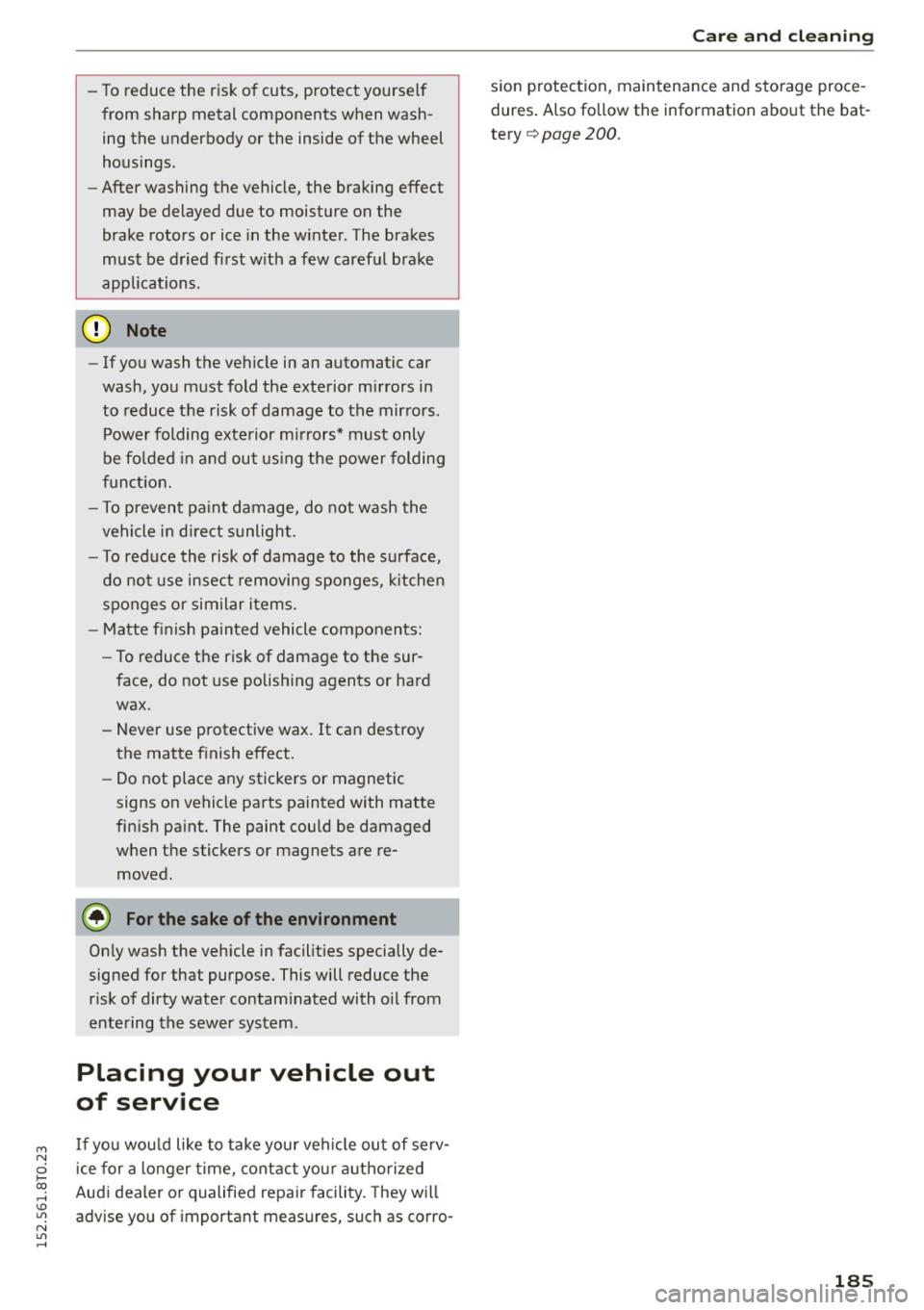
M N
i? co ,...., \!) 1.1'1
N 1.1'1 ,....,
-To reduce the risk of cuts, protect yourself
from sharp metal components when wash
ing the underbody or the inside of the wheel
housings.
- After washing the vehicle, the braking effect
may be delayed due to moisture on the
brake rotors or ice in the w inter . The brakes
must be dried first w ith a few careful brake
applications.
(I) Note
- If you wash the vehicle in an automatic car
wash, you must fold the exterior m irrors in
to reduce the risk of damage to the mirrors. Power folding exterior mirrors* must only
be fo lded in and out us ing the power folding
f u nct ion.
- To prevent pa int damage, do not wash the
vehicle i n direct sunlight .
- To reduce the risk of damage to the surface,
do not use insect removing sponges, k itche n
sponges or similar items.
- Matte finish painted vehicle components:
- To reduce the risk of damage to the sur-
face, do not use polishing agents or hard
wax.
- Never use protective wax.
It can destroy
the matte finish effect.
- Do not place any stickers or magnetic
signs on vehicle parts painted with matte
finish pa int. The paint could be damaged
when the stickers or magnets are re
moved.
@ For the sake of the environment
On ly wash the vehicle in facilit ies specially de
signed for that purpose. This will reduce the
risk of dirty water contam inated with o il from
entering the sewer system .
Placing your vehicle out
of service
If you wou ld like to take your vehicle out of serv
ice for a longer time, contact you r authorized
Audi dealer or qualified repair facility. They will
adv ise you of important measur es, such as corro-
Care and cleaning
sion p rotection , maintenance and storage proce
dures . Also follow the information about the bat
tery
C) pag e 200.
185
Page 202 of 264
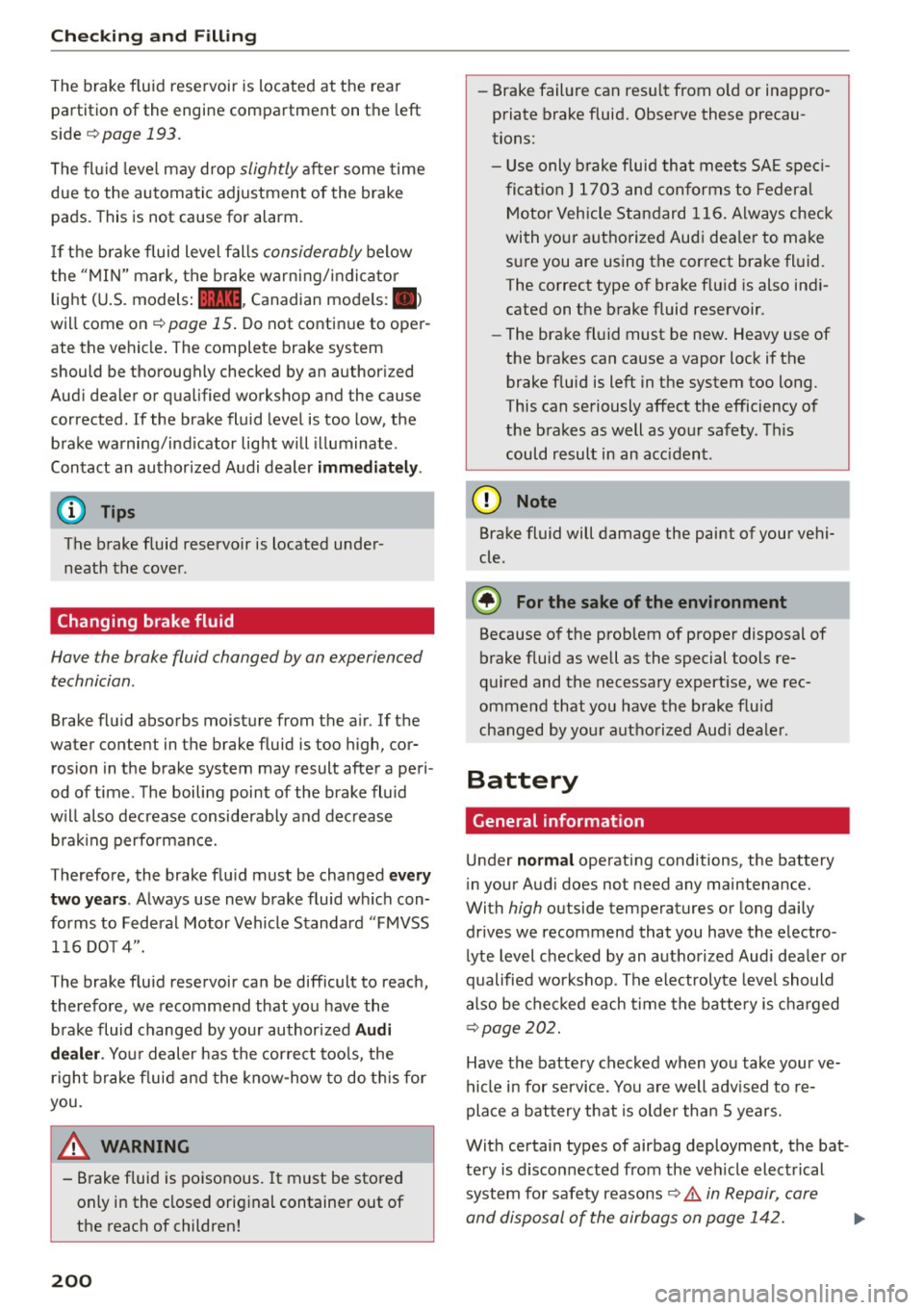
Checking and F ill in g
The brake fluid reservoir is located at the rear
partition of the engine compartment on t he left
side
c!,> page 193.
The fl uid level may drop slightly after some time
due to the automatic adjustment of the brake
pads. This is not cause for alarm.
If the b ra ke fluid level fal ls considerably below
the "MIN" mark, the brake warn ing/indicator
light (U.S. models:
1111 , Canadian models: . )
will come on
c!,> page 15 . Do not contin ue to oper
ate the vehicle . The complete brake system
should be thoroughly checked by an author iz ed
Aud i dealer or qualified workshop and the cause
corrected . If the brake fluid level is too low, the
brake warning/ind icator light w ill illuminate .
Contact an authorized Audi dealer
i mmed iately .
{D) Tips
The brake fluid reservoir is located under
neath the cove r.
Changing brake fluid
Have the brake fluid changed by an experienced
technician .
Brake fluid absorbs moist ure from the a ir. If the
water content in the brake fluid is too high, cor rosion in the brake system may result after a peri
od of time . The boiling point of the brake flu id
w ill also decrease conside rably and dec rease
b rak ing perfo rmance.
Therefore, the brake flu id must be changed
e ve ry
two year s.
Always use new brake fluid w hich con
forms to Fede ral Motor Vehicle Standard "FMVSS
1 16 DOT 4".
The brake fluid rese rvoir can be difficult to reach,
therefo re , we recommend that you have the
b rake fluid changed by your author ized
Audi
dealer .
Your dealer has the correct too ls , the
right brake fluid and the know-how to do t his for
you.
A WARNING
- B rake fluid is poisonous. It must be stored
on ly in the closed original container out of
the reach of children!
200
- Brake fail ure can resu lt from o ld or inappro
priate brake fluid. Observe these precau
tions:
- Use only b rake fluid that meets SAE spec i
f ica tion
J 170 3 and conform s to Federa l
Motor Vehicle Standard 116. Always check
with yo ur autho rized Audi dea le r to make
su re you are using the correct brake fl uid.
The correct type of brake flu id is also ind i
cated on the brake fluid reservoir.
- The brake fl uid must be new. Heavy use of
the brakes can cause a vapor lock if the
brake f luid is left in the system too long.
This can seriously affect the efficiency of
the brakes as well as your safety. This
could result in an acc ident.
(D Note
Brake fluid will damage the paint of your vehi
cle.
@ For the sake of the env ironment
Because of the prob lem of prope r disposal of
brake fluid as well as the special tools re
qu ired and the necessary expert ise, we rec
omme nd that you have the brake flu id
changed by you r autho rized Aud i dea le r.
Battery
, General information
U nder normal operating conditions, the battery
i n your Audi does not need any maintenance.
Wi th
high outside temperatures or long daily
drives we recommend that you have the e lectro
lyte level checked by an a uth orized Aud i deale r o r
qualified workshop . The electrolyte leve l should
a lso be checked each time the batte ry is c ha rged
c:!,> page 202.
Have the battery checked when yo u take your ve
hicle in for service . You a re well adv ised to re
pla ce a battery that is older tha n 5 years.
With certain types of airbag deployment, the bat
te ry is disconnected from the veh icle elect rical
system for safety reasons
c:!,> & in Repair, care
and disposal of the airbags on page 1 42.
Page 209 of 264
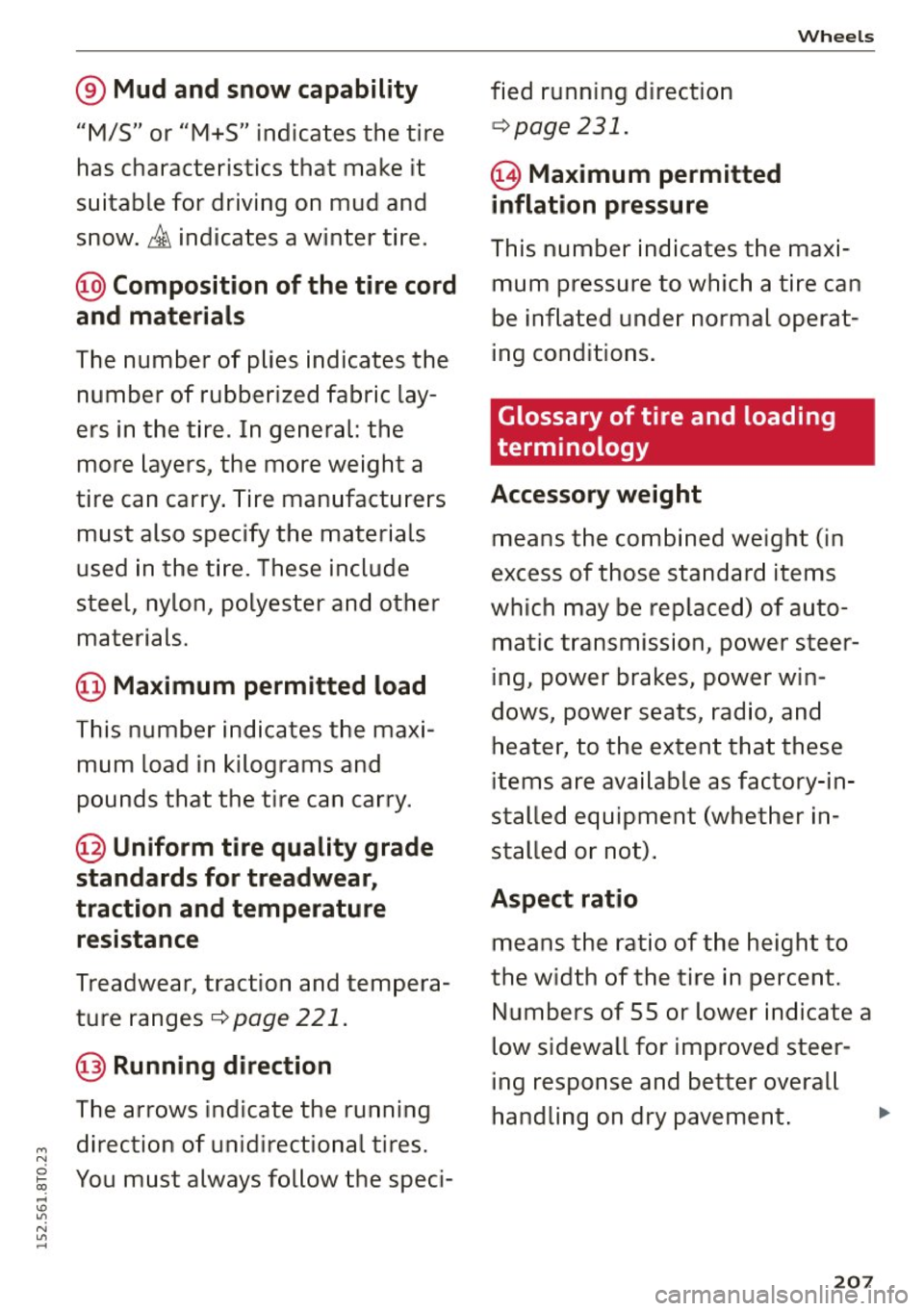
® Mud and snow capability
"M/S" or "M+S" indicates the tire
has characte ris tics that make it
suitable for driving on mud and snow .
& indica tes a winter tire.
@ Composition of the tire cord
and materials
T he number of plies indicates the
number of rubber ized fabric lay
ers in the tire . In general: the
more layers, the more weight a
tire can carry. Tire manufacturers
must also specify the mater ials
used in the ti re. These include
stee l, nylon, polyester and other
materials.
@ Maximum permitted load
This number indicates the maxi
mum load in kilograms and
pounds that the tire can carry .
@ Uniform tire quality grade
standards for treadwear,
traction and temperature resistance
Treadwear , traction and tempera
ture ranges¢
page 221.
@Running direction
The arrows ind icate the running
direction of unidirect ional tires.
You must always follow the speci- fied running direction
¢
page 231.
€3) Ma ximum permitted
inflation pressure
Whe els
This number indicates the maxi
mum pressure to which a tire can
be inflated unde r normal operat
ing conditions .
Glossary of tire and loading
terminology
Accessory weight
means the combined weight (in
excess of those standard items
which may be replaced) of auto matic transmission, power steer
ing, power brakes, power win
dows, power seats, radio, and
heater, to the extent that these
items are available as factory-in
stalled equipment (whether in
stalled or not).
Aspect ratio
means the ratio of the height to
the width of the tire in percent. Numbers of 55 or lower indicate a
low s idewall for improved steer
ing response and better overall
handling on dry pavement . .,.
207
Page 211 of 264
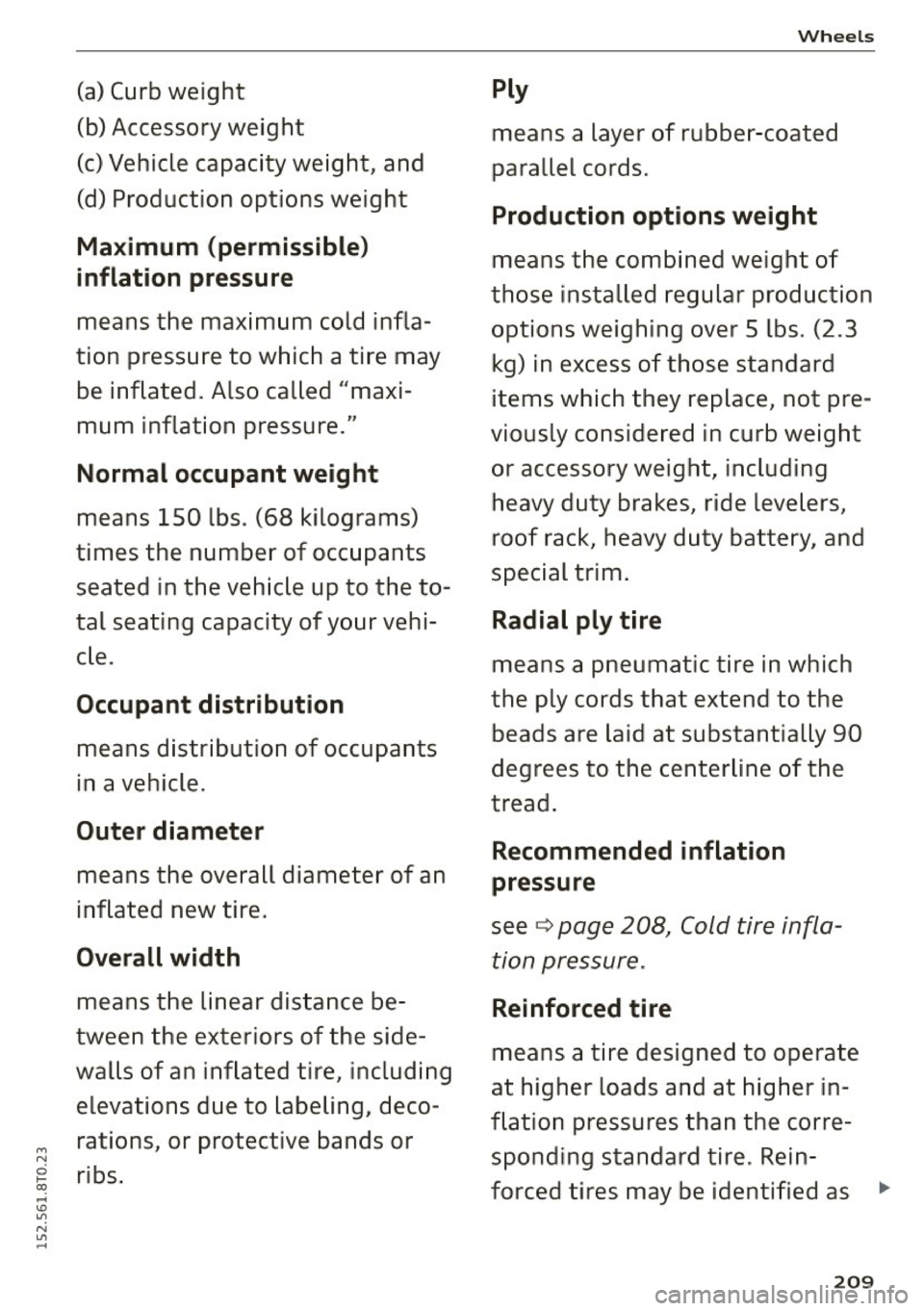
(a) Curb weight
(b) Accessory weight
(c) Vehicle capacity weight, and
(d) Product ion options weight
Maximum (permissible)
inflation pressure
means the max im um cold infla
tion pressu re to which a tire may
be inflated . Also called "ma xi
mum inflation pressure ."
Normal occupant weight
means 150 lbs . (68 kilog rams)
times the number of occupants
seated in the veh ic le up to the to
tal seating capacity of yo ur vehi
c le.
Occupant distribution
means d istr ibution of occupants
in a vehicle.
Outer diameter
means the overall diameter of an
inflated new tire .
Overall width
means the linear dis tance be
tween the exter iors of the side
walls of an inflated tire , including
elevations d ue to labe ling, deco
rations , or protective bands or
ribs .
Whee ls
Ply
means a layer of rubbe r-coated
parallel cords .
Production options weight
means the comb ined weight o f
those installed regular production
options weighing over 5 lbs . (2 .3
kg) in excess o f those s tandard
items which they re place , not pre
viously conside red in c urb weight
or accessory weight, including heavy duty brakes, ride levelers,
roof rac k, heavy d uty batte ry, and
specia l trim .
Radial ply tire
means a pneumat ic t ire in which
the ply cords that ex tend to the
beads are la id at substantially 90
degrees to the centerli ne of the
tread .
Recommended inflation
pressure
see ~ page 208, Cold tire infla
tion pressure .
Reinforced tire
means a tire designed to operate
at higher loads and at h igher in
flat ion pressures than the corre
spon ding standard tire . Rein
f orced tires may be identified as
2 0 9
Page 220 of 264
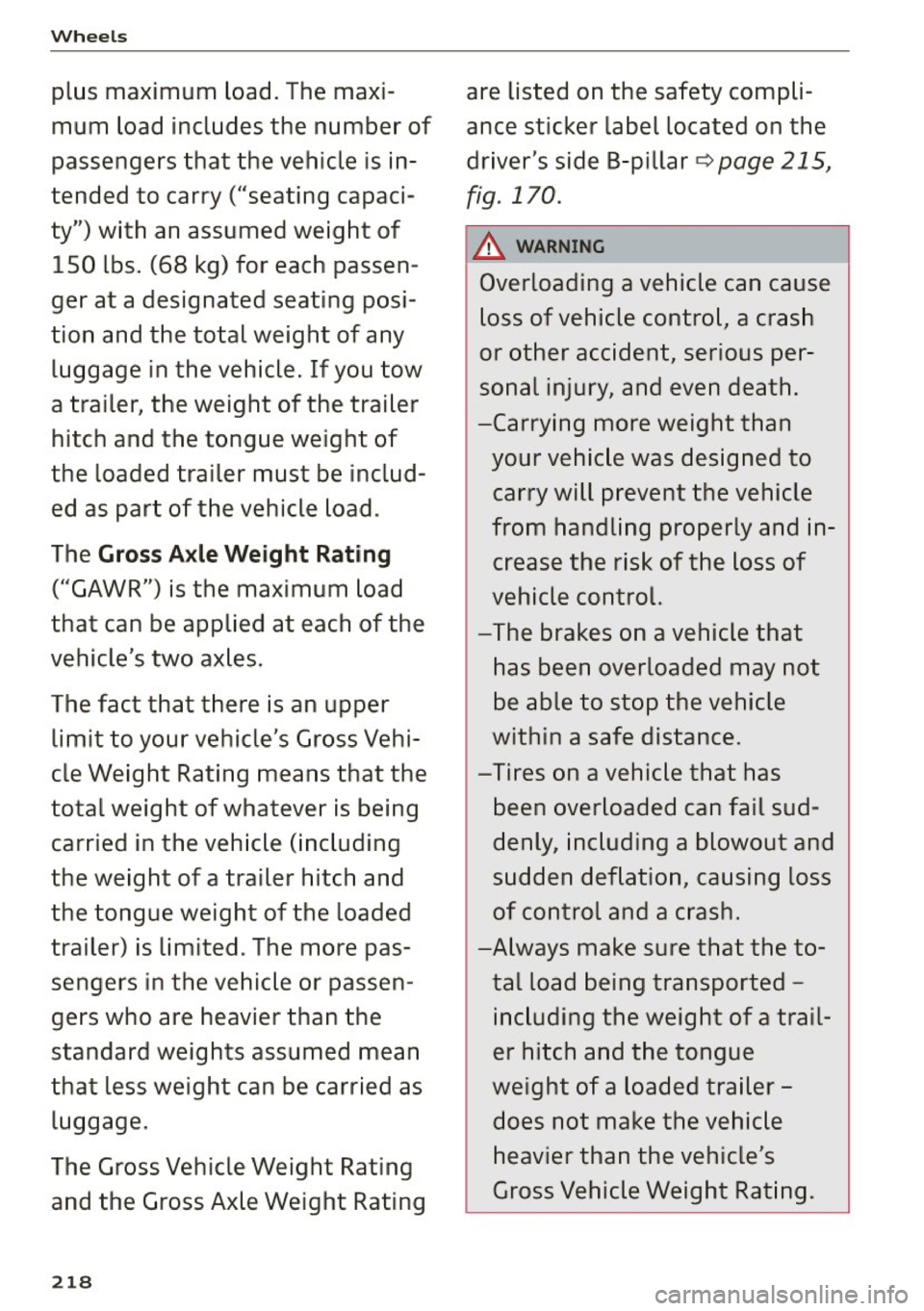
Wheels
plus maximum load. The maxi
mum load includes the number of
passengers that the vehicle is in
tended to carry ("seating capaci
ty") with an assumed weight of 150 lbs. (68 kg) for each passen
ger at a designated seating posi
tion and the total weight of any luggage in the vehicle. If you tow
a trailer, the weight of the trailer
hitch and the tongue weight of
the loaded trailer must be includ
ed as part of the vehicle load .
The
Gross Axle Weight Rating
("GAWR") is the maximum load
that can be applied at each of the
vehicle's two axles.
The fact that there is an upper
limit to your vehicle's Gross Vehi
cle Weight Rating means that the
total weight of whatever is being
carried in the vehicle (including
the weight of a trailer hitch and
the tongue weight of the loaded
trailer) is limited . The more pas
sengers in the vehicle or passen
gers who are heavier than the
standard weights assumed mean
that less weight can be carried as
luggage.
The Gross Vehicle Weight Rating and the Gross Axle Weight Rating
218
are listed on the safety compli
ance sticker label located on the
driver's side B-pillar
¢ page 215,
fig . 170.
.&_ WARNING ~ -
Overloading a vehicle can cause
loss of vehicle control, a crash
or other accident, serious per
sonal injury, and even death.
-Carrying more weight than your vehicle was designed to
carry will prevent the vehicle
from handling properly and in
crease the risk of the loss of
vehicle control.
-The brakes on a vehicle that
has been overloaded may not
be able to stop the vehicle
within a safe distance .
-Tires on a vehicle that has been overloaded can fail sud
denly, including a blowout and
sudden deflation, causing loss
of control and a crash.
-Always make sure that the to tal load being transported -
including the weight of a trail
er hitch and the tongue
weight of a loaded trailer
does not make the vehicle
heavier than the vehicle's
Gross Vehicle Weight Rating.
Page 251 of 264
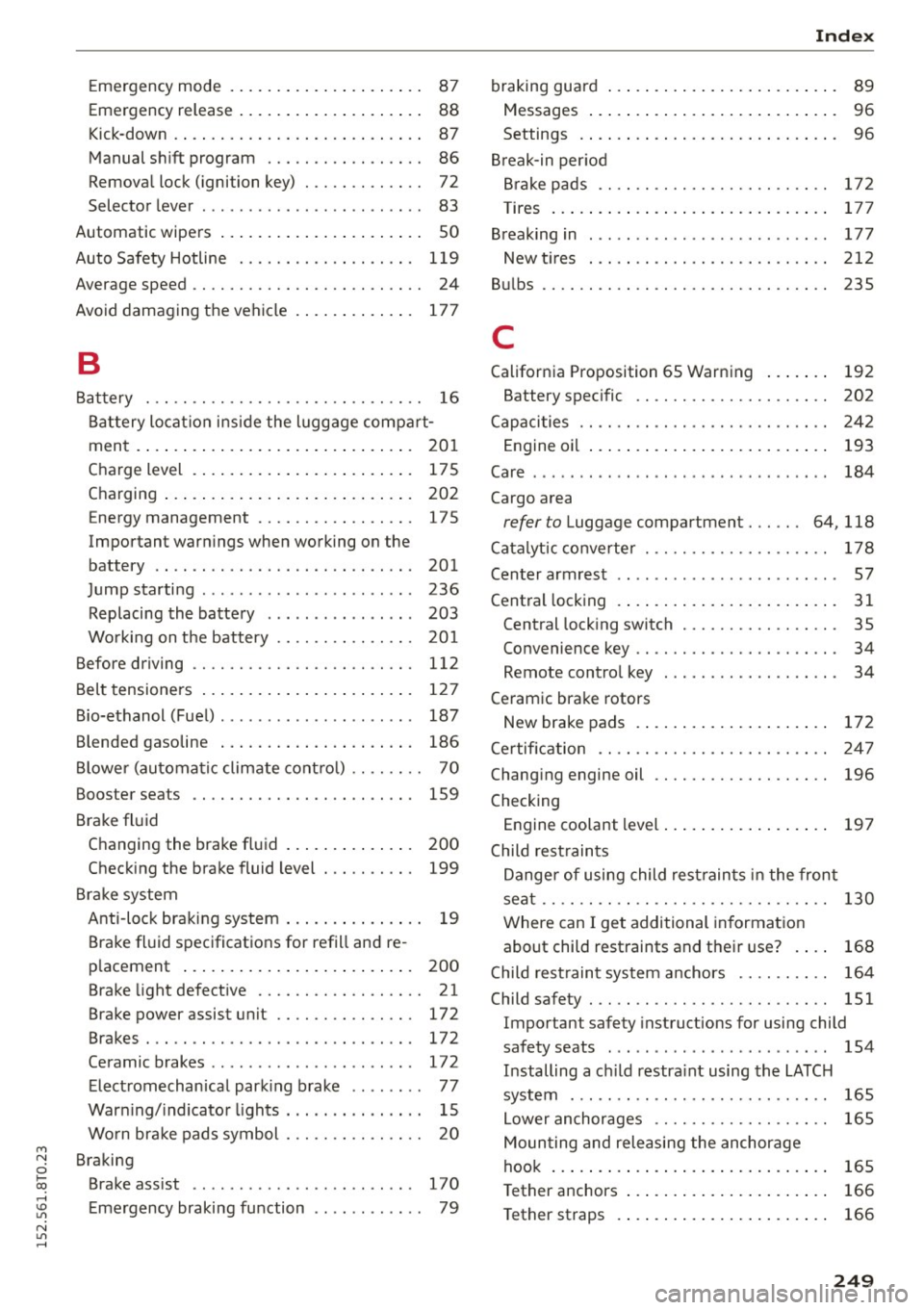
M
Emergency mode . . . . . . . . . . . . . . . . . . . . . 87
Emergency release . . . . . . . . . . . . . . . . . . . . 88
K ick -down . . . . . . . . . . . . . . . . . . . . . . . . . . . 87
Manual shi ft program . . . . . . . . . . . . . . . . . 86
Remova l lock (ignition key) . . . . . . . . . . . . . 72
Selector leve r . . . . . . . . . . . . . . . . . . . . . . . . 83
Automatic wipe rs . . . . . . . . . . . . . . . . . . . . . . 50
Auto Safety Hotline . . . . . . . . . . . . . . . . . . . 119
Average speed . . . . . . . . . . . . . . . . . . . . . . . . . 24
Avoid damaging the vehicle . . . . . . . . . . . . . 17 7
B
Batte ry . . . . . . . . . . . . . . . . . . . . . . . . . . . . . . 16
B att ery lo cati on in side the lugg age comp art-
men t .... .. .. .... .. .... ... .. .. .... . 20 1
C harge level . . . . . . . . . . . . . . . . . . . . . . . . 17 5
C harging . . . . . . . . . . . . . . . . . . . . . . . . . . . 202
Energy management ................ .
Important warn ings when wo rking on the
battery .. ...... .......... ... .. .. .. .
J ump starting ...................... .
Replacing the batte ry ...... ...... ... .
Wo rking on t he battery .............. .
Before driving 175
201
236
203
20 1
112
Belt tensioners . . . . . . . . . . . . . . . . . . . . . . . 12 7
Bio-ethanol (Fue l) . . . . . . . . . . . . . . . . . . . . . 187
Blended gasoline . . . . . . . . . . . . . . . . . . . . . 186
B lower (automa tic climate cont rol) . . . . . . . . 70
Booster seats . . . . . . . . . . . . . . . . . . . . . . . . 159
Brake fl uid
C hanging the brake fl uid . . . . . . . . . . . . . . 200
Checking the brake fluid level . . . . . . . . . . 199
B rake system
Anti-loc k bra king system . . . . . . . . . . . . . . . 1 9
Brake fl uid specifications for refill and re
p lacement . . . . . . . . . . . . . . . . . . . . . . . . . 200
Brake light defect ive . . . . . . . . . . . . . . . . . . 21
Brake power assist unit ............... 172
Brakes . . . . . . . . . . . . . . . . . . . . . . . . . . . . . 172
Ceramic brakes . . . . . . . . . . . . . . . . . . . . . . 172
Elect romechan ica l park ing brake . . . . . . . . 77
War ning/ indicato r lights . . . . . . . . . . . . . . . 15
Wo rn brake pad s symbol . . . . . . . . . . . . . . . 20
N Braking
~ Brake assist . . . . . . . . . . . . . . . . . . . . . . . . 170
; Eme rgency braking function . . . . . . . . . . . . 79
N l/'I ,....,
Index
braking guard
Messages . . .
. . . . . . . . . . . . . . . . . . . . . . 89
96
Settings . . . . . . . . . . . . . . . . . . . . . . . . . . . . 96
Br eak-in per iod
Br ake pads .... .. ............. .... . .
T ires
B reaking in ........ ............... .. . 172
17
7
177
New t ires ... .. .. .. ........... .. .. .. 212
Bul bs . . . . . . . . . . . . . . . . . . . . . . . . . . . . . . . 235
C
Californ ia Proposition 65 War ning
Battery specific 192
202
C apaci ties . . . . . . . . . . . . . . . . . . . . . . . . . . . 242
E ngine oi l . . . . . . . . . . . . . . . . . . . . . . . . . . 193
Care . . . . . . . . . . . . . . . . . . . . . . . . . . . . . . . . 184
Cargo area
refer to Luggage compartment ..... . 64, 118
Catalyt ic converter . . . . . . . . . . . . . . . . . . . . 178
Cen ter armrest . . . . . . . . . . . . . . . . . . . . . . . . 5 7
Central lock ing . . . . . . . . . . . . . . . . . . . . . . . . 31
Central lock ing switch . . . . . . . . . . . . . . . . . 35
Convenience key . . . . . . . . . . . . . . . . . . . . . . 34
Remote contro l key . . . . . . . . . . . . . . . . . . . 34
Ceramic bra ke rotors
New brake pads . . . . . . . . . . . . . . . . . . . . . 172
Ce rtification . . . . . . . . . . . . . . . . . . . . . . . . . 24 7
Chang ing engine oil . . . . . . . . . . . . . . . . . . . 196
Checking Engine coolant level . . . . . . . . . . . . . . . . . . 197
Child rest raints
D anger of using child rest rain ts in the front
sea t............................... 130
Where can I get additional in format io n
about child restraints and the ir use? . . . . 168
Child rest raint system a nchors . . . . . . . . . . 164
Child safety . . . . . . . . . . . . . . . . . . . . . . . . . . 151
Important safety instructions for using child
safety seats . . . . . . . . . . . . . . . . . . . . . . . . 154
I n stalling a c hild restra int using th e LATCH
system . . . . . . . . . . . . . . . . . . . . . . . . . . . . 165
L ower anchorages . . . . . . . . . . . . . . . . . . . 165
Moun ting and rele asing the anchorage
hook . . . . . . . . . . . . . . . . . . . . . . . . . . . . . . 165
T ether anchors . . . . . . . . . . . . . . . . . . . . . . 166
T ether straps . . . . . . . . . . . . . . . . . . . . . . . 166
249